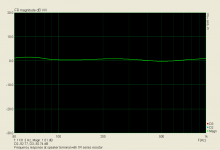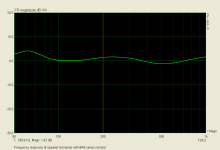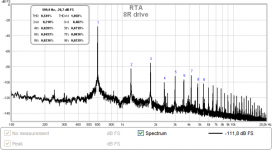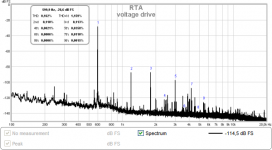Not I, unfortunately....all comments that I have read are complimentary in the bass, not so much for the highs....Phillips tweeter 12kHz resonance ?.
I have the little Sony's that I mention, and I spent a day with Genesis 1 system.
2000W + 2000W 16 Hz to 120 Hz in a very large room blurred ones vision and felt good, way good.
Yeah, ime servo bass is good, really good.
I repaired one when I was an apprentice.
Back then I did not have the experience/appreciation/discrimination that I now have so I can't give proper comment on those...sorry about that.
My big PA amp quotes DF of 500 with 4 ohm load..when running two cabinets per channel the bass results were really good, particularly on transient sounds like rock drums and bass guitar, and I do reckon that the DF is part of that.
There are all sorts of arguments both ways (low or high DF).
What does damping factor really mean ?.
The usual test method describes AC output impedance.
The practical reality is the amplifier's ability/efficacy to quench loudspeaker kinetically derived return energy.
Power supply low resistance DC connections and power supply LF low impedance AC behaviour are the critical factors here, as are earthing arrangements.
The loudspeaker return energy has to go somewhere, and into the reservoir caps is where it ends up, and in so doing modulates the amplifier power rails.
This all sets up a loop condition, with NFB and PSRR being further critical behaviours.
Get all of that right and you get a dynamically load invariant amp.
Far too many amplifiers suffer at least one if not all of the above dependencies.
Dan.
Yes, the Philips "yellow" dome tweeter did leave something to be desired. That's why it's perhaps paradoxical that the Grundig version, which used different dome midrange and tweeter drivers, possibly from Peerless, was a better deal, even if the company was a daughter company of Philips. I don't know whether they used the same power amps or different ones, but I wouldn't be surprised if they too were different, Grundig was damn good at designing them.
Is the spectrum normalized to the frequency response change?
No. But attached now is a frequency response plot at speaker terminals with 1 ohm and 6.8 ohm series resistors used in the test, to 1kHz (10th harmonic of 100Hz test sine). You can see that for 1 ohm the deviation is almost negligible, for 6.8 ohm and 200Hz (2nd harmonic) it makes 1.4 dB and in fact the measured distortion at 2nd harmonic is lower than on the plot. So, the conclusion is valid, speaker current distortion with 6R8 in series is about half of that with 1R.
Attachments
Am I missing something here? Take a non-linear resistance, add a linear resistor in series with it, and the result is more linear. Just to check: Pavel is measuring the distortion in the current, not the acoustic output?
You are absolutely correct. It is a distortion in speaker current, which reflects main sources of speaker acoustical distortion. Acoustical measurement would never have this resolution and accuracy. Some acoustical measurements were shown several days ago, but microphone was blamed for distortion, which is only partly true. Please check older posts, I know it is boring, but repeating ourselves is boring as well.
I know it is boring, but repeating ourselves is boring as well.
This is not boring at all. I'm glad you guys are talking about speakers.
Changing Two Variables ????
A speaker is a current operated device.
Why are your measurements at different current levels ?.
Dan.
Our ears respond to acousticals, not voice coil currents.You are absolutely correct. It is a distortion in speaker current, which reflects main sources of speaker acoustical distortion. Acoustical measurement would never have this resolution and accuracy. Some acoustical measurements were shown several days ago, but microphone was blamed for distortion, which is only partly true. Please check older posts, I know it is boring, but repeating ourselves is boring as well.
A speaker is a current operated device.
Why are your measurements at different current levels ?.
Dan.
Last edited:
No. But attached now is a frequency response plot at speaker terminals with 1 ohm and 6.8 ohm series resistors used in the test, to 1kHz (10th harmonic of 100Hz test sine). You can see that for 1 ohm the deviation is almost negligible, for 6.8 ohm and 200Hz (2nd harmonic) it makes 1.4 dB and in fact the measured distortion at 2nd harmonic is lower than on the plot. So, the conclusion is valid, speaker current distortion with 6R8 in series is about half of that with 1R.
Thanks, Pavel. Nice to see actual data.
How many here have heard the Philips Motional Feedback speaker models in real life? As either Philips or Grundig?
I still have a pair I inherited from my dad and they are very good for their time. One of the great innovations on them was placement control in order to adjust the FR to the boundary gain in a specific location.
There is no such thing as a flat speaker, there are just speakers that are flat under specific circumstances, and Philips was one of the first to realize that. On the whole, Philips was top notch with their loudspeaker and they had a whole loudspeaker lab including anechoic room in Dendermonde, Belgium, but they closed down afaik.
Last edited:
Given that part of the nonlinearity in a speaker is mechanical, and this is to some extent coupled to the electrical side, and remembering that an electric motor will vary its current draw according to its load, could it be argued that nonlinearity in speaker current is a good thing as it is partially compensating for mechanical nonlinearity? Therefore it should be encouraged by using a pure voltage source.
Yes, that is my experience.Given that part of the nonlinearity in a speaker is mechanical, and this is to some extent coupled to the electrical side, and remembering that an electric motor will vary its current draw according to its load, could it be argued that nonlinearity in speaker current is a good thing as it is partially compensating for mechanical nonlinearity? Therefore it should be encouraged by using a pure voltage source.
That said, the pure voltage source needs to be 'perfectly' coupled to the speaker in question.
So, that means any parasitic cable characteristics will have an influence, in both forward power and return power.
Amplifier forward power output impedance over frequency and over power delivery, and amplifier return energy quenching over frequency will have further influence.
So therefore, expect amplifiers and cables to cause speakers to sound differently....QED.
Dan.
Last edited:
Circa 1930 Voigt and Lowther were doing this.
Thornsten was also mentioning Eckmiller http://www.diyaudio.com/forums/lounge/200865-sound-quality-vs-measurements-482.html#post3002630
I really miss Thorsten to disagree with. At this point, let me rephrase why you want as little as possible mechanical resistance in a loudspeaker.
1) mechanical resistance is typically highly non-linear and may introduce stiction. All this leads to distortion.
2) mechanical resistance may be a source of unwanted sound production in and by itself.
2) Lower Qms creates lower efficiency.
For this reason, you want to have as high a Qms as possible. Look for example at what JBL does.
It is total system Q which matters for impuls reproduction, and Qms is just one of the parameters in this, and one which should be as high as possible.
Another question is current drive; even partial current drive can lower distortion.
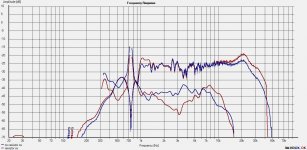
This is an acoustic measurement of the same tweeter with voltage drive (blue) and with partial current drive (brown) by putting an 8 Ohm resistor in series with it. The acoustic levels where matched by increasing the gain for partial current drive. It does lower distortion to some extent, but not over the whole frequency band.
As to Keantoken's question about a shortening ring impacting on back EMF: no, it doesn't. It just limits flux modulation, so as a matter of fact it would even (very slightly) increase EMF.
DF96 came with the simplest possible explanation, and I like it very much.
I = V/(Z lin + Z nonlin)
The bigger the Z lin (linear) impedance, the better I linearity. That's why inserted resistor decreases distortion.
I = V/(Z lin + Z nonlin)
The bigger the Z lin (linear) impedance, the better I linearity. That's why inserted resistor decreases distortion.
What does damping factor really mean ?.
The usual test method describes AC output impedance.
The practical reality is the amplifier's ability/efficacy to quench loudspeaker kinetically derived return energy.
Power supply low resistance DC connections and power supply LF low impedance AC behaviour are the critical factors here, as are earthing arrangements.
The loudspeaker return energy has to go somewhere, and into the reservoir caps is where it ends up, and in so doing modulates the amplifier power rails.
This all sets up a loop condition, with NFB and PSRR being further critical behaviours.
Get all of that right and you get a dynamically load invariant amp.
Far too many amplifiers suffer at least one if not all of the above dependencies.
Dan.
Hm. Amplifiers Damping factor cannot be very important for passive speakers with passive x-overs, since the losses of of x-over parts, connectors and wiring are at least 0,2 Ohms ( i guess), in practice more, maybe 0,4 ohms, this will bring the damping factor in the area of apx. 10.
But if an amp has 400 or 1000, this cannot differ so much.
So it will have some influence for the Q with usual speakers.
Planars are different anyway.
So,
Lc = L1 + L2*abs(d(Vc))
where Vc is the coil displacement?
Pretty much. Unfortunately, it is also not as easy to assume that inductance will go down as the coil leaves the gap. DC inductance will go down because reluctance increases, but the lenz effect at the iron surfaces tries to exclude the flux at frequency, this due to iron conductivity. So, exercising xmax with a secondary frequency on the coil can actually cause the hf inductance to modulate based on twice the frequency driving the xmax, with inductance rising as the coil leaves the gap and is no longer being confined by lenz. This is opposite the effect being seen by low frequencies.
Attempting to analytically derive that is way beyond me.And what is the R and L values of the skin effect and eddy currents proportional to?
Attempts to measure them are full of confounders. Dissipative losses in the system are at 90 degrees to the inductance, but trying to isolate the energy delivered to the air as sound from the energy lost in the copper and lost in the iron and suspension is not easy to do. Locked coil measurements can isolate out the primary eddy losses in the iron and copper. Measurements in free air and in vacuum can find suspension losses added to copper/iron.
I've been thinking about how to drive a coil within a vc gap where there is no magnetic field, the coil being driven by a hf signal while the coil is driven physically at a low frequency to measure eddy losses and lenz effect due to motion. But so far, it's just thinkin..
jn
Am I missing something here? Take a non-linear resistance, add a linear resistor in series with it, and the result is more linear. Just to check: Pavel is measuring the distortion in the current, not the acoustic output?
That is my issue as well - current distortion is simply a reflection of other
problems. Eliminating it by using a current source is not a cure for those.
😎
Exactly, at acoustical side it looks quite opposite..The same speaker, voltage driven and through series resistor, to the same SPLThat is my issue as well - current distortion is simply a reflection of other
problems. Eliminating it by using a current source is not a cure for those.
😎
Attachments
Last edited:
Now, where do we stand? Is current drive worth it or not? What about the phase response of the speaker AFTER we compensate for the frequency response with an equalizer? The measurements are great, however, keep them coming!
One problem that I see here is that many of you live and work with cheap speakers, yet the ongoing discussion is on premium electronics. I might agree that the factors that I am still concerned with in electronics are not very important with an old AR speaker, for example, or even worse (in fabrication and measurement)
Are you sure it wasn't your amp having to swing twice the volts ?Exactly, at acoustical side it looks quite opposite..The same speaker, voltage driven and through series resistor, to the same SPL
Nice demo 🙂
This was exactly what i said current drive is worse than voltage drive as it gives consistent drive to a VC where the forces are changing with motion and position, this is bound to yield higher acoustic distortion. with voltage drive these force induced currents just adds and subtracts to the expected (no motion) impedance based current. whit is really interesting here is the effect this induced current has on the feedback. and will there be a big difference between voltage and current feedback amplifiers
- Status
- Not open for further replies.
- Home
- Member Areas
- The Lounge
- John Curl's Blowtorch preamplifier part II

